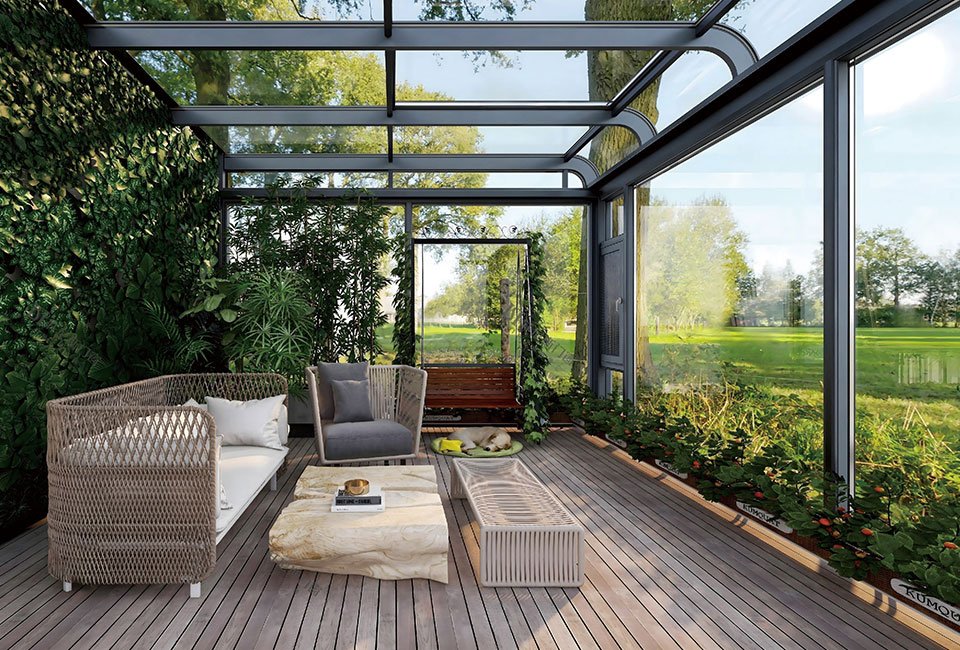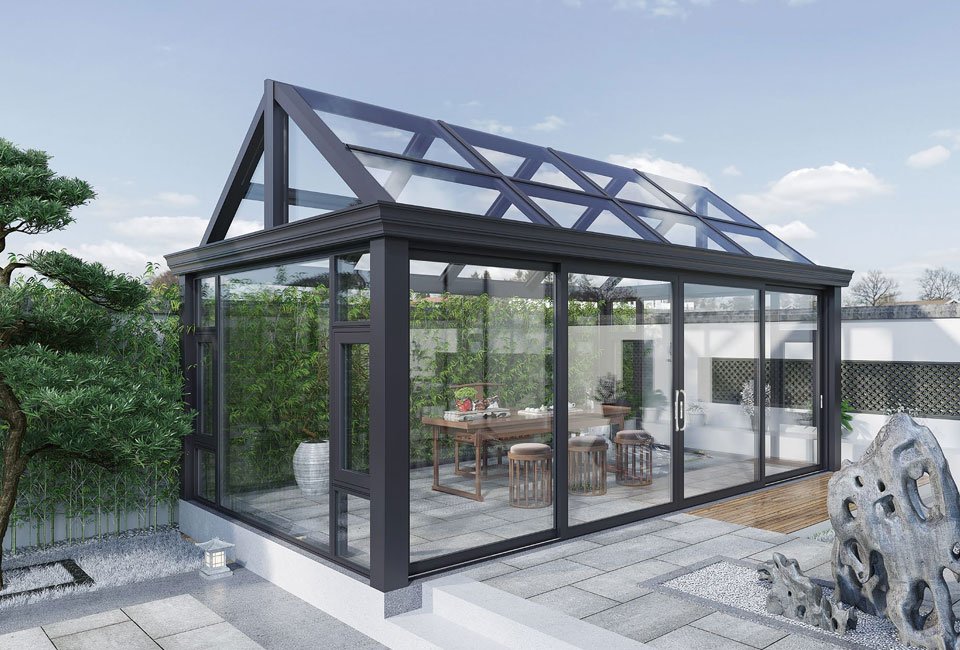When planning your sunroom, one of the most important decisions you’ll make is choosing the right glazing material for your windows and roof. The two most popular options are tempered glass and polycarbonate. Both materials offer unique advantages and some potential drawbacks, depending on your needs. Here’s a breakdown of each material to help you decide which one is best for your sunroom.
1. Durability and Strength
Tempered Glass
Tempered glass is known for its high strength, as it is heat-treated to withstand a significant amount of pressure and force. When it breaks, it shatters into small, rounded pieces, making it safer than regular glass. However, while tempered glass is very strong, it can still break under extreme force or impact, such as from heavy debris or strong winds.
Polycarbonate
Polycarbonate is a plastic material that is far stronger than glass. It is known for its impact resistance, being up to 200 times stronger than glass. Polycarbonate is highly durable and can withstand extreme weather conditions, such as hail, high winds, and falling debris. While it can scratch more easily than glass, it is much less likely to break.
Verdict: Polycarbonate is the winner in terms of impact resistance and overall durability, particularly for areas with harsh weather conditions.


2. Energy Efficiency
Tempered Glass
Tempered glass is an excellent option for maximizing natural light, and it has great insulation properties, especially when paired with double glazing or Low-E glass. This makes it a good choice for improving energy efficiency in your sunroom. However, traditional glass does not provide the same level of insulation as polycarbonate, especially in extremely cold or hot climates.
Polycarbonate
Polycarbonate offers excellent insulation properties. Multi-wall polycarbonate panels are especially effective in preventing heat transfer, keeping your sunroom warm in winter and cool in summer. The air pockets within the multi-wall structure act as insulators, providing better thermal resistance than single-pane tempered glass. Polycarbonate can significantly reduce heating and cooling costs in your sunroom.
Verdict: Polycarbonate has better insulation and energy efficiency, making it ideal for maintaining a comfortable temperature in your sunroom year-round.
3. Light Transmission
Tempered Glass
Tempered glass allows for optimal light transmission, providing clear views and an open, airy feel to your sunroom. It is highly transparent and doesn’t have any tinting or color distortion, which means it offers the best clarity. However, too much direct sunlight can sometimes lead to uncomfortable heat buildup in the room, especially during the summer months.
Polycarbonate
Polycarbonate also allows for a significant amount of light to enter your sunroom, but it is typically slightly tinted, which can reduce glare and provide some UV protection. While it may not provide the same level of crystal-clear clarity as tempered glass, polycarbonate still offers excellent light diffusion, and multi-wall polycarbonate can offer additional UV filtering, which protects furniture and flooring from sun damage.
Verdict: Tempered glass offers better clarity, while polycarbonate provides good light transmission with the added benefit of UV protection.
4. Cost
Tempered Glass
Tempered glass is typically more expensive than polycarbonate, especially when opting for energy-efficient versions like Low-E glass or double glazing. The cost of tempered glass can be a factor if you are working within a specific budget. However, it offers a longer lifespan and more aesthetic appeal, especially if you are looking for a premium look for your sunroom.
Polycarbonate
Polycarbonate is usually a more affordable option, especially when comparing it to high-end tempered glass options. While polycarbonate may be cheaper upfront, you may need to replace scratched panels over time. However, the long-term savings on energy costs due to better insulation can offset the initial price difference.
Verdict: Polycarbonate is the more affordable option upfront, but tempered glass offers a more premium look and longer lifespan.
5. Maintenance
Tempered Glass
Tempered glass is relatively low-maintenance. It’s easy to clean with basic glass cleaners and doesn’t require frequent upkeep. However, glass can be more prone to stains or smudges, especially if it’s exposed to rain or outdoor elements. Tempered glass is also prone to scratching if not treated with care.
Polycarbonate
Polycarbonate requires a bit more maintenance, especially in terms of protecting it from scratches. Polycarbonate is more vulnerable to scratches than tempered glass, and harsh cleaning methods can damage the surface. It’s also important to clean polycarbonate with non-abrasive materials and use UV-resistant coatings to maintain its appearance and longevity.
Verdict: Tempered glass is easier to maintain and clean, while polycarbonate requires more careful handling to avoid scratches.
6. Aesthetics
Tempered Glass
Tempered glass offers a sleek and modern look with clear, unobstructed views. It enhances the aesthetic appeal of your sunroom, providing an elegant, high-end appearance. If you’re looking for a clear, sophisticated design, tempered glass is the way to go.
Polycarbonate
Polycarbonate panels have a more industrial or functional look. While modern designs can still make polycarbonate look attractive, it generally does not provide the same refined, transparent appearance as glass. However, polycarbonate does offer various textures and finishes, which can give a more unique, customized look to your sunroom.
Verdict: Tempered glass is the superior choice for aesthetics, providing a clean, high-end look with clear views.
7. UV Protection
Tempered Glass
Tempered glass naturally blocks some UV rays but does not provide the same level of protection as polycarbonate. To enhance UV protection, additional treatments or coatings (like Low-E glass) may be required, which can increase the cost.
Polycarbonate
Polycarbonate provides excellent UV protection, especially with UV-resistant coatings. Polycarbonate can block up to 99% of harmful UV rays, protecting your furniture, flooring, and other interior elements from fading or sun damage. This is an especially important feature for sunrooms in regions with high sun exposure.
Verdict: Polycarbonate wins in UV protection, making it the best option for protecting both the interior of your sunroom and your health.


Conclusion
When choosing between tempered glass and polycarbonate for your sunroom, it’s essential to weigh your priorities. Here’s a summary to guide your decision:
- Tempered Glass: Offers superior clarity, aesthetics, and a premium look. It’s ideal for homeowners who want crystal-clear views and are willing to invest in higher upfront costs for a long-lasting material.
- Polycarbonate: Provides better insulation, durability, impact resistance, and UV protection, making it ideal for harsh climates or those looking for a more affordable option with better energy efficiency.
Ultimately, the best choice depends on your budget, climate, and aesthetic preferences. Both materials can work well in a sunroom, but they offer different advantages in terms of strength, energy efficiency, and appearance.
At Delanshini Doors and Windows, we specialize in high-quality materials for sunrooms, offering both tempered glass and polycarbonate solutions to suit your needs. Contact us today at wang@gddlsn.com to learn more about the best options for your sunroom project!
Sunroom Series
How to Insulate a Sunroom for All-Season Use
How to Keep Your Sunroom Cool in Summer
Winterizing Your Sunroom: Tips to Stay Warm
Transform Your Sunroom into a Cozy Winter Retreat
Best Window Treatments for Sunrooms in Different Seasons
Energy-Efficient Sunrooms: How to Reduce Heating and Cooling Costs
Tempered Glass vs. Polycarbonate: Which Is Best for Your Sunroom?
